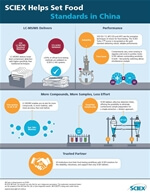 One of the biggest concerns of Chinese citizens is food safety1. Even though China ranks second in global economies2, crowding, industrial pollution, labor and certain agriculture practices have contributed to this. In October 2015, however, we began to see a turnaround as the Chinese government revised its 2009 Food Safety Law in an attempt to strengthen its food supply oversight and quality.Get to know the technology >
One of the biggest concerns of Chinese citizens is food safety1. Even though China ranks second in global economies2, crowding, industrial pollution, labor and certain agriculture practices have contributed to this. In October 2015, however, we began to see a turnaround as the Chinese government revised its 2009 Food Safety Law in an attempt to strengthen its food supply oversight and quality.Get to know the technology >
Take a look at articles 84 -90 for instance which require food inspection take place by accredited inspectors and labs. This is an opportunity to see where routine instruments such as the X500R QTOF are ideally suited for technicians in need of simplified, yet high performing mass spectrometers. To get a better perspective of its performance, we’ve designed an infographic which portrays how SCIEX Helps Set Food Standards in China. Included is a tally of standard and validated methods using the LC-MS/MS technology, performance capabilities, matrice tests and simplified sample prep logistics –the perfect tool for sharing the X500R QTOF’s abilities at a glance with the rest of your lab.
Along with food safety revisions, the 2015 US Foreign Supplier Verification Program (FSVP) has meant companies must be able to stand by their imports to avoid issues that have occurred in the past, such as melamine in milk and horse meat found in advertised beef products. Therefore, if we can make affordable and compact mass spec instruments more accessible to Chinese inspectors, it could lead to greater compliance with the FSVP. Certainly, high-performance testing is just one of the factors to improve food quality, but it is a step in the right direction especially given the Chinese Food and Drug Administration (CFDA) had half a million complaints last year. The X500R QTOF delivers on performance.
- http://usa.chinadaily.com.cn/china/2015-03/04/content_19720813.htm
- http://money.cnn.com/news/economy/world_economies_gdp/






 Contact Support
Contact Support
0 Comments